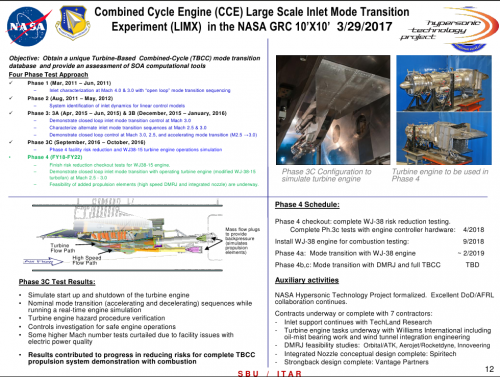The Pentagon has formally changed the name of its marquee effort to develop a long-range, hypersonic weapon, eliminating "global" from what used to be called the Conventional Prompt Global Strike program -- a rebranding that comes as the top brass have refined the underlying requirement for a high-speed, boost-glide weapon.
Defense Department leaders are refining their vision for what is now called Conventional Prompt Strike, establishing a broader framework for capabilities the U.S. military needs to hit critical targets on short notice called Time-Sensitive Target Engagement Weapons (TSTEW), according to a Joint Staff official.
The Joint Requirements Oversight Council -- led by Vice Chairman of the Joint Chiefs of Staff Gen. Paul Selva -- convened on Sept. 27, 2016 to review matters, including the need for a hypersonic strike weapon, Joint Staff spokeswoman Maj. Lisa Lawrence told Inside Defense.
"TSTEW serves as the new umbrella term that encompasses the capability requirements," Lawrence said in an email statement of the JROC meeting last fall. "The resultant classified JROC memorandum reiterated the validity of the previously approved PGS ICD and provided updated guidance for further analysis of the topic,” she added, using DOD's acronym for Prompt Global Strike initial capability document.
Since 2003, the Defense Department has explored a range of options for giving commanders new ways to strike high-value, time-sensitive targets -- from terrorists to weapons of mass destruction to anti-satellite weapons -- anywhere on the planet in about an hour. DOD officials believe such a capability would allow the United States to go after very important targets without resorting to nuclear weapons and provide “precision and responsiveness” in anti-access, area-denial environments, while simultaneously minimizing unintended military, political, environmental, economic or cultural consequences.
In 2013, the JROC validated the requirement for a hypersonic weapon, directing that the program now called Conventional Prompt Strike focus on demonstrating the feasibility of a hypersonic, boost-glide weapon for a potential intermediate-range strike system that could be deployed "independent of service of basing/platform," according to DOD.
Conventional Prompt Strike, according to Lawrence, is "just one part of a larger 'Family of Systems' the DOD is exploring to address this warfighting challenge."
The Conventional Prompt Strike program aims to produce results to support a milestone A decision by the end of fiscal year 2020, a move that would formally begin an acquisition program of record to field a hypersonic capability.
Cmdr. Patrick Evans, a spokesman for the Conventional Prompt Strike project in the Pentagon's acquisition directorate for strategic warfare, told Inside Defense the new name for the project replaces the "previously named Conventional Prompt Global Strike."
A major test event planned for this year is back on track after an unnamed issue threatened to delay the test, according to Evans. Congress cut $20 million from the Pentagon's $181 million request for what is now the Conventional Prompt Strike program in DOD's portion of the Fiscal Year 2017 omnibus spending bill, citing a "schedule slip."
"The issues that caused the referenced delay, which occurred in February 2016, have been resolved, and [Flight Experiment]-1 remains on track for a flight test in 2017," Evans said.
In 2011, the Army -- which was commissioned to work on a hypersonic capability as a hedge against failure of an Air Force hypersonic weapon project -- successfully demonstrated an Advanced Hypersonic Weapon, a so-called boost-glide system that paired a three-stage rocket with a cone-shaped hypersonic glide vehicle.
The AHW was designed to launch along a trajectory different than that of a ballistic missile, never leaving the atmosphere. It released a cone-shaped glide vehicle designed by Sandia National Laboratories to travel at hypersonic speeds, defined as at least five times the speed of sound or at least 3,600 miles per hour.
During a planned second flight test of the AHW in 2014, however, a problem unrelated to the warhead prompted officials to abort the mission seconds after takeoff. The Pentagon's acquisition directorate for strategic warfare then tapped the Navy to conduct the next test flight by modifying the Army-developed Advanced Hypersonic Weapon to fit in a submarine missile tube and launch the prototype weapon from a land-based test facility.
That event -- FE-1 -- will demonstrate advanced avionics, miniaturization of subsystems, manufacturability and guidance algorithms, according to DOD. The component miniaturization is supposed to support accommodation of a hypersonic glide body that could be deployed on land, sea or air platforms, DOD officials have testified.
"To date, the national team has successfully demonstrated applicable components and subsystems through a series of ground and flight experiments," Evans said. "The next major system-level technology demonstration is Flight Experiment-1 (FE-1). The FE-1 technology demonstration will build on lessons learned from the Advanced Hypersonic Weapon flight demonstrations: FT-1A (2011) and FT-2 (2014)."
Evans said the Conventional Prompt Strike program was established to conduct risk-reduction efforts supporting development and demonstration of technologies and applications that advance conventional prompt strike warfighting capabilities.
"The program utilizes a national team approach with active participation from all services, national laboratories, and industry," the Pentagon spokesman said. "The program's emphasis is on demonstrating component and subsystem technology maturity with risk reduction initiatives culminating in operationally relevant fight tests. The program funds the design, development, and experimentation of boosters, payload delivery vehicles, conventional warheads, thermal protection systems, guidance systems, test range modernization, and mission planning and enabling capabilities."
China and Russia are actively working to also develop a hypersonic capability, flight testing the DF-FZ and 3K22 Tsirkon systems respectively, according to a DOD official.
The JROC last year assured the heads of U.S. European and Pacific commands, who are watching China and Russia routinely flight test high-speed weapons, that "certain" hypersonic strike capabilities would be fielded within the FY-17 to FY-22 future years defense plan.





